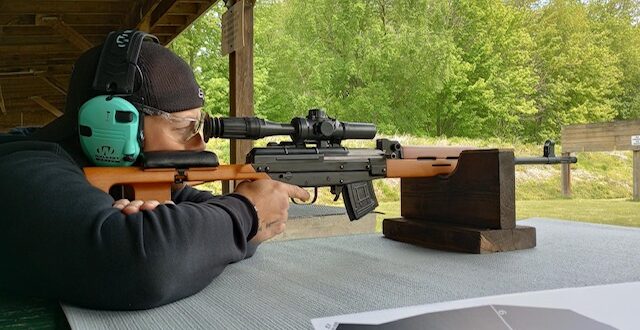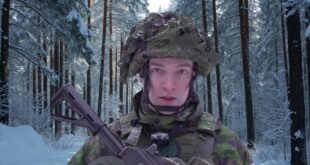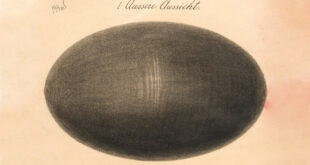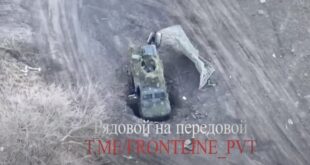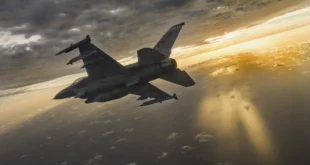By Royce de Melo
Our correspondent has high hopes for his new sniper rifle, but finds that the knockoff Soviet-style Dragunov has a few surprises.
As soon as we finished the club’s Saturday morning orientation for new members, I went out the main building’s door and headed to the 300-yard range to try out my new Type 81 SR (Sporting Rifle) with a Russian scope. I was looking forward to putting this rifle and the scope to the test at 300 yards, although I had already fired my cousin’s SR on the same range just a few weeks earlier and, honestly, it didn’t go too well.
Being at The East Elgin Sportsmen’s Association (EESA) orientation was quite a contrast from only a couple of weeks earlier when I was stateside at the NRA Whittington Center in New Mexico with friends shooting targets at up to 1,550 yards. There are not many 300-yard civilian ranges in Ontario, Canada. The EESA’s 300-yard range was one of the deciding factors for me to join this club, although overall, it is a very good club.
When I arrived at the 300-yard range, my cousin Kevin and his friend, Ryan—a first-timer at a range and around guns– had already been there a while.
“That took longer than I thought it would,” Kevin said. While waiting for me they had thrown rounds down range for a while, shooting at two 300-yard steel plates using a Lee–Enfield No. 4 Mk I, a Remington 308, and Kevin’s own Type 81 SR with Russian scope, the same rifle I had fired three weeks earlier.
Kevin and I had both bought our Type 81 SRs from the same store, which obligated buyers to buy the rifle with a Russian NPZ PO4x24 scope. Initially, I wanted to buy only the Russian scope because these are hard to find these days; but, excuse the Britishism, the store “wouldn’t have it.”
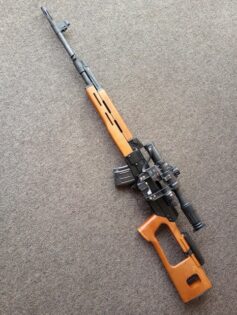
The reason the NPZ PO4x24 scope is difficult to find should be obvious: Russian sanctions due to the war in Ukraine. The store insisted that they would not sell the two items separately, despite these being two different products from different countries — a Russian scope mounted on a Chinese-made rifle. At the time, I could not find any other NPZ PO4x24 Russian scopes available anywhere in Canada online except at this store, and they were down to two rifles and two scopes. I had to give in and buy the rifle and scope package. I hope that at least the scope is a good investment, and the value will increase over time.
The Type 81 SR and the Type 81 (T81) SA (Semi-Automatic) rifles and LMG (Light Machine Gun) versions in Canada are made in China by Poly Tech, all chambered in 7.62×39mm. The SR has been referred to as Canada’s SVD Dragunov. The SVD Dragunov (Снайперская Винтовка системы Драгунова образца; or, Snayperskaya Vintovka sistem’y Dragunova obraz’tsa 1963 goda, translation: ’Sniper Rifle, System of Dragunov, Model of the Year 1963′), often simply referred to as a Dragunov, is a sleek looking and effective Soviet-era sniper rifle designed in 1963.
Canadians are prohibited from owning the Dragunov, so the Chinese knockoff SR is the closest thing Canadians have to the famous Russian sniper rifle, at least in looks anyways. Whereas Canada’s neighbours to the south can buy AKMs and Dragunovs, in Canada AKMs are prohibited. Meanwhile, on the other side of the coin, Chinese firearms and ammunition products are banned in the U.S.
The Type 81 systems in Canada are only available in semi-automatic versions, including the Type 81 LMG, as automatic firearms are prohibited in Canada. The original T81 rifle is a gas-operated rifle that has a mix of AK-47, Type 56 (Chinese version of the AK-47), and SKS actions. The T81 SA rifle version is sometimes referred to as the AK of Canada. The Type 81 SR is fundamentally a reconfigured T81 SA rifle, while the action type is basically the same as an SVD with a short-stroke gas piston.
One major difference between the SR and the Dragunov is that the SR is chambered in the 7.62×39mm calibre, an intermediate Soviet cartridge that is not a particularly good round for accuracy and long range. The Dragunov is chambered in the far more effective and accurate 7.62x54R. Chambering the SR in 7.62×39mm calibre alone works against it being a reliable precision rifle.
The Type 81 assault rifle was first developed in China for the People’s Liberation Army (PLA) in the early 80s, and has since been used by a variety of state and non-state actors in Asia, the Middle East, and Africa. Unlike the Type 81 rifle, the Type 81 SR has not been battle-tested. The SR version is designed for sporting purposes with a heavier longer barrel, and is specifically made for the Canadian civilian market.
On that range day, right off the bat, there were problems with my new out-of-the-box SR. The SR comes with a cheek rest made to fit onto an indent in the butt stock to be latched into place. In my case, hooking the cheek rest to the stock was difficult as it seemed much too tight. When trying to latch the cheek rest to lock in place, the hook piece broke off so the cheek rest could no longer be attached.
My cousin’s SR cheek rest fit on his rifle no problem (I contacted the store for a replacement and the distributor kindly mailed me a new cheek rest free of charge).
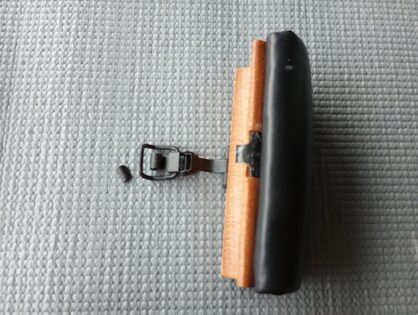
Making do without a cheek rest, I went for one of the 300-yard metal plates instead of first sighting in the rifle at 100 yards, as one should probably do with this Russian scope.
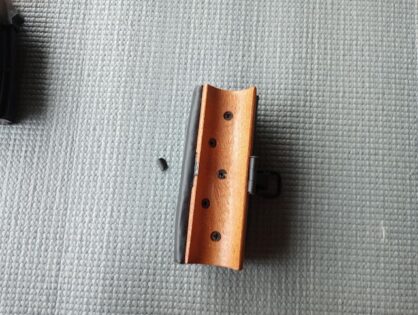
I admit I was using some relatively inexpensive Chinese-made Norinco non-corrosive 7.62×39 ammunition. With some good spotting from Ryan—again, it was his first time around guns, the range and spotting—I managed to hit the plate, but there were far too many wide flyaway rounds. It seemed so random, going far right or extremely high or low off the mark.
Now, I admit this could be a problem with me and my aim, but this could be a problem with the rifle—keep in mind that only a couple of weeks earlier I was hitting targets at the NRAWC at 1,000, 1,123 and 1,550 yds with various calibres. However, a few days before I travelled to New Mexico, Kevin and I had shot his SR with similar results, i.e., random flyaway rounds. On that morning with Kevin and Ryan firing my new SR, we also had the same results with the two different SRs.
The SR has a rough, heavy trigger that locks before snapping back and firing. It is not the sort of trigger one would expect to be found on a precision rifle, but here it is. I suspect that the heavy jerking trigger is likely one of the factors causing random flyaway rounds.
The SR’s wooden front and butt stock feel and look like cheap wood. Within my first ten shots, the front stock had a dent in it from a barrel rest I was using.
“No worries, it gives it character,” Kevin said.
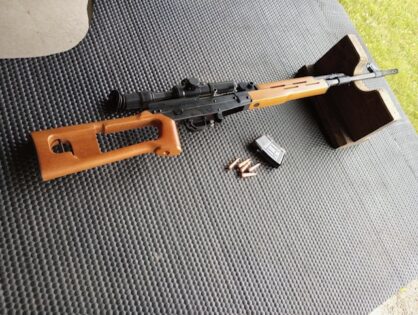
Another problem is the 5-round magazine—Canada has a 5-round long gun magazine capacity restriction—and the magazine slot. For whatever reasons, inserting the magazine into the slot can be cumbersome at times. The magazine will frequently lock into place improperly, fooling you into thinking it is fitted correctly in position when it’s not so that when cocking the action, a round will not chamber. And sometimes when the mag is not properly in place, the magazine will get stuck, leaving one trying to figure out a trick to get it unstuck. Believe me, this is more a design flaw than a user’s flaw.
A week later, after a bit of research and being much more focused and aware of the heavy jerking trigger, I returned to the 300-yard range, this time to first sight in the rifle at 100 yards. With aiming compensations, windage and elevation adjustments on the scope, and ever so aware of the trigger pull, the results were confusing; there would be a fantastic MOA, and random flyaway rounds again. After firing several rounds, finally, I adjusted the aim, so I was hitting bullseyes relatively consistently, and with fewer far-flung flyaway shots. I was pleased but not super pleased! I still had to compensate by aiming at the bottom of the target.
During this shooting session, I noticed that the front iron sight had moved all the way to the right and was just about to fall off. I do not think it unreasonable to expect a new rifle not to have bits falling off it after a handful of shots.
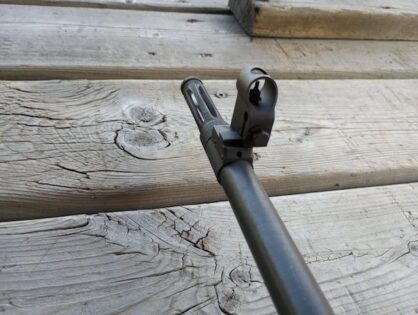
Relatively pleased that I finally had my SR more or less sighted in at 100 yards, resigning myself that this was the best this rifle can do, I decided to put a new target up at 100 yards again. I aimed as I did before, focused on the trigger pull, and sent. High right! Bugger! The next few shots were all way off the mark. What the F—?! How?!
I tried readjusting my visual aim according to where the previous shot landed, and when that didn’t work, I reluctantly fiddled with the scope again. The results were inconsistent. I gave up. Perhaps the rifle getting hot and then cooling down had some bearing. I don’t know. Was the inexpensive ammunition also a factor? And/or is the rifle itself much to blame? Was it me?! I don’t know, but I will risk saying that I believe this is more a rifle issue than anything else.
Weeks later I took the rifle out again for a range day with Kevin, who also brought his Type 81 SR. At that point, I had fired my SR far more than he had. However, he had managed to more or less sight in his rifle at 300 yards as best as could be expected; and he seemed to be having none of the problems with his rifle and parts in general as I had with mine.
After a few shots at 100 yards, I noticed something was jostling. The scope was loose—something I had not noticed when I shot the rifle a few weeks earlier. Needless to say, a loose-fitting rifle scope of course is going to affect accuracy. Nonetheless, a new rifle like this, designed to fit this Russian scope, should not have the scope coming loose like this. By luck, another shooter at the range had an Allen Key so I could tighten the two holding screws on the right side of the rifle.
Later on, Kevin’s SR was hitting the plate at 300 yards easily enough with the odd flyaway round. The grouping was all over the plate but at least mainly hitting the plate. So, I gave Kevin’s SR a go. Other than a couple of flyaway rounds, every shot hit the plate. With that we can confirm it’s not me but my rifle that is the problem.
As I told Kevin, I had heard that after a number of shots have been put through the SR, the accuracy will improve.
When I tried my own SR at 300 yards, there was hope. After some adjustments on the scope, I was hitting the plate, but suddenly there were more and more flyaway rounds. With each shot, the scope loosened again.
When I put my rifle away on one of the racks to shoot other rifles, I noticed that there was a crack in my butt stock. Yes, a crack. Weeks earlier a friend had told me that his SR buttstock had broken. It seems to be a thing, SR buttstocks breaking. Cheap wood.
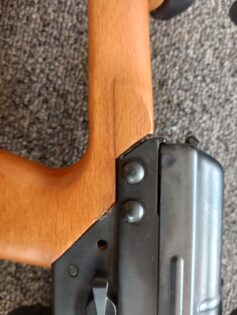
The problems with the SR don’t end there. The next day, after tightening the holding screws for the scope, something else was jostling. The buttstock was loose. With a cracked stock and a loosening scope, I had not noticed the day before that one of the retainer pins that hold the buttstock in place was popping out of the left side of the rifle.
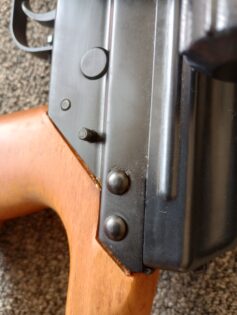
The shooting must have forced the pin out of its place and this is why the buttstock was loose. It’s an easy fix putting the pin back into place; but, again, a new rifle or any good quality rifle should not have bits and pieces coming loose and falling off while it’s doing what it’s designed to do.
I did reach out to the distributor regarding the cracked stock and the issue with the retaining pins. The company was kind enough to send me a Gen 2 buttstock that has a lifetime guarantee and two spare retaining pins at no cost. This led me to wonder why they have readily available sturdier Gen 2 buttstocks for the SR. Is it because broken buttocks are a common problem?
The fact that Kevin has so far been having fewer problems with his SR could simply be because I have been shooting my rifle far more than he has fired his, and/or it could be a problem with the lot number, or luck of the draw.
The Type 81 SR is not a precision rifle, and it doesn’t compare to the SVD Dragunov except for some exterior looks and a similar short-stroke gas piston action type. For a sporting rifle that has parts and pieces falling off and loosening after a bit of shooting, an accessory breaking, that has a heavy jerking trigger, lacks accuracy, has magazine loading issues, and cheap wood that leads to broken stocks, the SR is a relatively expensive rifle at roughly CAD$1,499.95 (roughly USD$1,114.98).
I’m going to say it, the SR is made in China so perhaps expectations should be measured accordingly. I don’t think our friends to the south are missing much. The SR is a very cool-looking showpiece for Canadians while the rifle is probably better suited for fun shooting rather than as a reliable and rugged sporting precision rifle.
But I really do like the Russian scope.
Royce de Melo is a Canadian analyst and security and defense consultant mainly covering the Middle East and Africa.
 Soldier of Fortune Magazine The Journal of Professional Adventurers
Soldier of Fortune Magazine The Journal of Professional Adventurers


